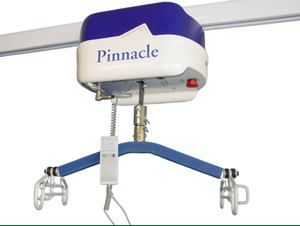Ceiling Track Installation - Part 1

Track installation for ceiling lifts is not something that should be attempted by people who aren't knowledgeable about construction techniques and comfortable with mechanical components.
I'm not going to provide a step by step installation procedure here; only an overview. My intention here is to talk about some of the issues that complicate track installation an how they are dealt with.
In a perfect world, ceiling tracks would be installed in straight lines at approximately 90° to the ceiling joists and those joists would be easily accessible from above.
In the real world, tracks are often installed with curves, parallel to the ceiling joists, with curves and through doorways.
Mounting Information
With minor differences between models, most track systems are installed by attaching clamps or brackets to the ceiling that provide the attachment points for the track sections. These brackets are installed by various methods as dictated by the manufacturer and the type of structure.
Usually the ceiling brackets are installed using threaded rod and uni-strut. The uni-strut is a channeled steel bar that is located above the ceiling joists to disperse the weight across several joists. The threaded rod is passed through the ceiling bracket, through the ceiling surface (normally drywall), between the joists and through the uni-strut.
In situations where there is no access to the area above the ceiling joists some type of suitable lag bolt must be used to lag the brackets into the joists.
Please note! The manufacturer's directions must be followed for an installation that will be safe for the user and others. This information is for general knowledge only and not intended to be directions.
Track Layout
There are a few ways to layout the tracking. The first and easiest is to place short track sections (4' to 8' lengths) in various locations where a ceiling lift is needed (bedroom, bathroom etc.).
The second type of layout involves having the track installed throughout the building in a continuous run or multiple tracks that intersect each other using a turntable to switch tracks. The track can start over a bed and travel along the ceiling to the bathroom and other rooms as required and will usually involve curves.
A third option for laying out the tracking is a wall mount system. In situation where the ceiling can't be used for mounting the track and the span is not too long the ends of the track can be mounted to opposite walls up to about 16' apart. For this type of installation a special reinforced track is used that is designed to span long distances without support along its length.
Another mounting system is one that I refer to as a gantry system. The gantry installation involves two tracks installed parallel to each other and a third track mounted to span the first two tracks. The spanning track is attached at its ends to carriages that travel along the first two tracks. With the gantry system the spanning track moves along the two outside tracks and the user can be moved along the spanning track. This system will allow a user to be picked up anywhere in a room and lower anywhere else within the gantry area.
The final option for installation is not really an installation. Some manufacturers have created portable systems that can be set up in a room for transferring users. The usually consist of two legs (one for each end of the track) and a single track segment that attaches to the legs. The advantage is that no installation or construction is required, the disadvantage is one, or both, legs will often be in the way for caregivers.
Part 2 - Obstacles and installation problems.


 Online Vendors
Online Vendors  US Online Vendors
US Online Vendors 